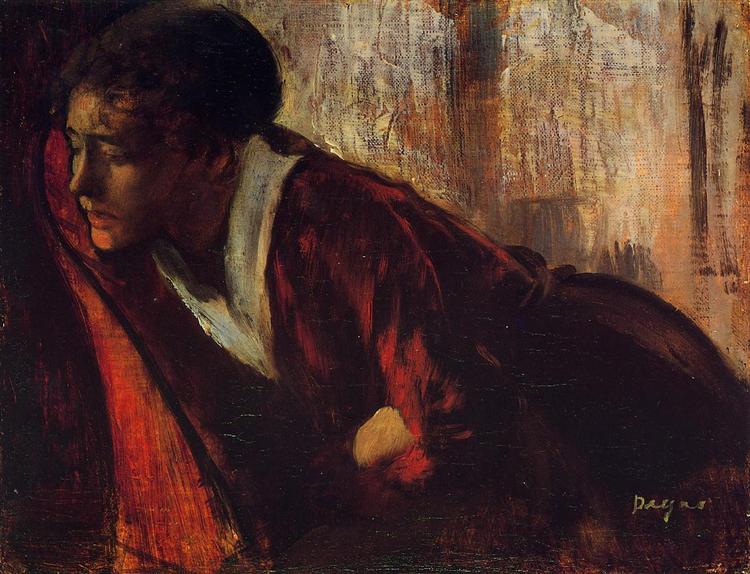Beskrivning
Edgar Degas' Melancholy, painted in 1874, is a profound testament to the emotional exploration that characterized much of 19th-century art, especially in the context of Impressionism and post-Impressionism. Degas, an artist often associated with depictions of ballet and female life in Paris, here delves into more introspective subject matter, evoking feelings of sadness and reflection.
The composition of Melancholy is notable for its simplicity and the depth of its emotional expression. In the center is a woman seated in an armchair, her head slightly bowed and an expression suggesting reflection or deep restlessness. The figure's posture, semi-reclining and with a lost gaze, captures the essence of melancholy; it is a moment of introspection that provokes in the viewer an emotional connection with the solitude that radiates from the scene. The choice of a female figure, a frequent resource in Degas' work, reinforces the themes of vulnerability and restlessness. Although we do not see concrete details that define her surroundings, the context can be read as a private space of contemplation.
The use of color is subtle and strategic. Degas' palette in "Melancholy" is predominantly soft and earthy, with muted greens and brown tones that contribute to the melancholic atmosphere of the work. These diffused colors not only establish an intimate atmosphere, but also reflect the emotional state of the figure depicted. The light, treated in an almost diffuse manner, envelops the figure in a way that adds a certain drama to the scene, but without falling into excess. This control of color and light is characteristic of Degas, who, throughout his career, showed a special interest in the treatment of space and color in his compositions.
Although Melancholia is not a work that directly resembles his studies of ballerinas or scenes of everyday Parisian life, it does share with them a particular attention to the human figure and how it can be a vehicle for emotion. Degas, with his training at the academy and his later evolution towards Impressionism, was a master at capturing the subtleties of the body and expression, and here he succeeds by emphasizing the moment of fragility. The choice of a simply suggested background, without explicit detail, allows the figure to lend its weight to the piece, focusing the viewer's attention without distraction.
In terms of context, it is relevant to mention that in the 1870s, Degas began to move away from purely allegorical representations and began to explore more complex psychological states. "Melancholia" can therefore be considered part of a series of works that address more sensitive and personal themes, reflecting his unique vision of art and the human being.
The painting is not only a portrait of an isolated figure, but also a mirror of the anguish that many people experience in their daily lives. Melancholia stands out as a work that, through its simplicity and emotionality, invites reflection both on Degas' art and on humanity itself. The elegance of form and depth of feeling make this work a milestone within his production and the art of its time, highlighting art's ability to express human pain and introspection in visually poetic and emotionally resonant ways.
KUADROS ©, a famous painting on your wall.
Hand-made oil painting reproductions, with the quality of professional artists and the distinctive seal of KUADROS ©.
Painting reproduction service with satisfaction guarantee. If you are not completely satisfied with the replica of your painting, we will refund 100% of your money.

